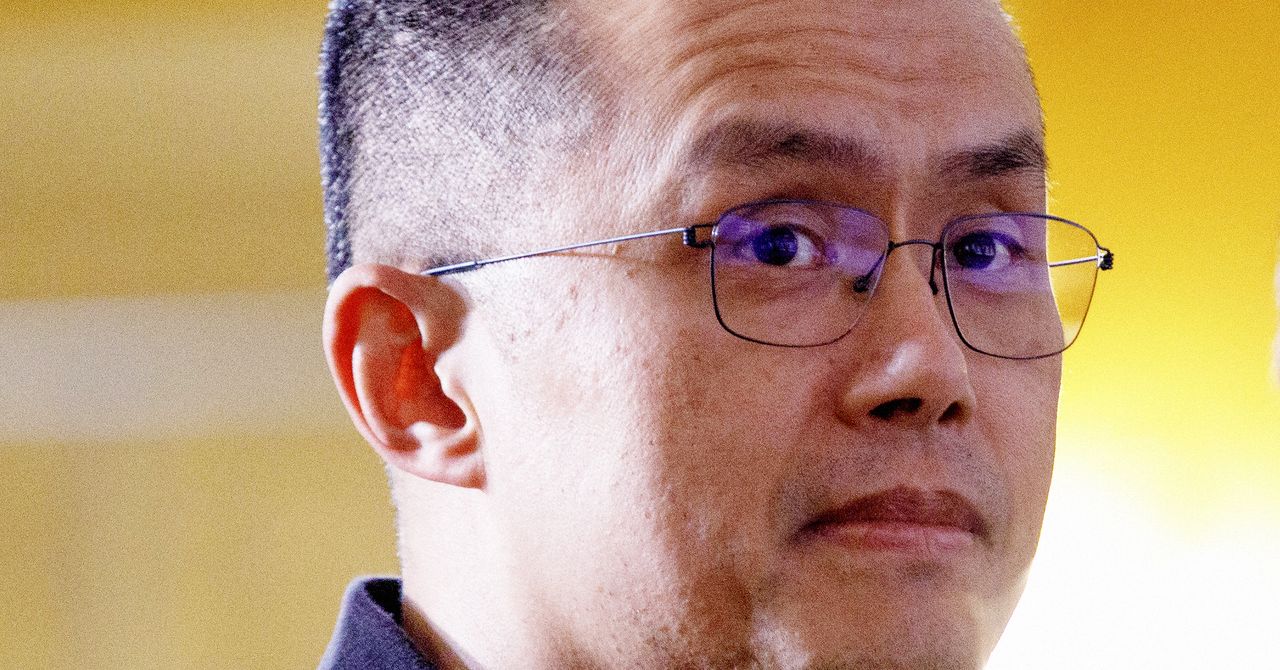Tech
Trump’s CZ Pardon Has the Crypto World Bracing for Impact

Changpeng Zhao, the multibillionaire founder of crypto exchange Binance, spent four months last year locked in a federal prison. After US president Donald Trump pardoned Zhao in October, the government has recast him as a martyr.
Zhao, who goes by CZ, pleaded guilty in November 2023 to failing to maintain an effective anti-money-laundering program at Binance. In parallel, Binance admitted to violating US sanctions and settled with financial regulators, which accused the company of failing to report suspicious transactions involving terror groups, child exploitation networks, and cybercriminals, among other violations. In a particularly incriminating exchange detailed in court documents, one Binance employee said to a colleague, “We see the bad, but we close 2 eyes.”
As part of their respective settlement deals, Zhao agreed to forfeit his role as Binance CEO, and Binance agreed to leave the US, accept supervision by a US-appointed compliance monitor, and pay a record $4.3 billion penalty.
Less than two years later, the narrative has flipped. On October 23, Trump struck the charges from Zhao’s criminal record. The Binance founder was a victim of the “Biden administration’s war on crypto,” a White House spokesperson declared.
The decision to pardon Zhao will reverberate throughout the US crypto exchange market, which Binance could seek to reenter, legal experts claim. It may also come with long-term political consequences for the crypto industry after Trump’s presidency ends.
Whether Zhao’s pardon was justified has been hotly disputed, particularly in light of connections between Binance and World Liberty Financial, a crypto business founded by Trump and his sons. (Through a corporate entity, the Trump family owns a 38 percent stake in World Liberty Financial’s parent company.) In May, Binance agreed to receive a $2 billion investment denominated in USD1, a coin issued by World Liberty Financial, which could earn tens of millions of dollars from the arrangement. In July, Bloomberg reported that Binance had developed the codebase for USD1.
Remarkably, Trump claims to know very little about Zhao. “OK, are you ready? I don’t know who he is,” Trump told 60 Minutes in an interview that aired on November 2. “I can only tell you this. My sons are into [crypto],” he said later in the interview.
Zhao’s legal representatives and industry allies have defended the pardon as a rightful corrective. “CZ is the first and only known first-time offender in US history to receive a prison sentence for this single, non-fraud-related charge,” wrote Teresa Goody Guillén, partner at law firm Baker & Hostetler, which represents Zhao, in a post on X.
Tech
With a Memory Shortage on the Horizon, Here’s Which MacBook to Buy

All of Apple’s processors are scattered throughout different MacBook models. While Apple only currently sells M4 MacBooks, you can find older models at specific third-party retailers online, either completely new or refurbished. If you do stumble upon its older chips (which came out four years ago), you might be wondering how they compare to other options. We break down the differences between each one.
M5 Series
M5: The rollout of the M5 line of chips has just started. The base M5 still has up to a 10-core CPU and 10-core GPU, although there’s also a lower-tier 9-core CPU that’s available in the iPad Pro—and presumably, that’ll also be offered in the M5 MacBook Air at some point. The M5 is around 10 to 15 percent faster in CPU performance, but also takes a significant step up in GPU, AI workloads, and even storage speed.
M4 Series
M4: The M4 originally launched in 2024. It has a 10-core CPU and a 10-core GPU. Apple claims it delivers 1.8 times faster CPU performance and 2.2 times faster GPU performance than the M1. Meanwhile, the neural engine is over three times faster than the original and twice as fast as the M3. It also starts with 16 GB of unified memory, which will help power Apple Intelligence (the company’s suite of artificial intelligence features) a lot more smoothly. It’s available on the 14-inch MacBook Pro (2024), iMac (2024), and MacBook Air (13-inch and 15-inch, 2025).
M4 Pro: The M4 Pro has a 14-core CPU (which Apple claims is up to 1.9 times faster than the M1 Pro) and up to a 20-core GPU, with up to 64 GB of unified memory. Built on a second-generation 3-nanometer process, it also supports enhanced GPU features like mesh shading and ray tracing—the latter of which is now twice as fast as on M3 chips. You’ll find it on the latest MacBook Pro (14-inch and 16-inch) and Mac Mini (2024).
M4 Max: This chip has a 16-core CPU and up to a 40-core GPU with support for up to 128 GB of unified memory. Apple says the CPU is up to 2.2 times faster than the M1 Max, while the GPU is up to 1.9 times faster. As with the M4 Pro, it packs support for mesh shading and ray tracing. The M4 Max is currently the most powerful chip you can get in a MacBook, and is available on the latest 14-inch and 16-inch MacBook Pro. You can also get it as an option in the current Mac Studio.
M3 Series
M3: The M3 is available on the 14-inch MacBook Pro (late 2023), 13-inch MacBook Air (2024), 15-inch MacBook Air (2024), and 24-inch iMac (2023). It packs an 8-core CPU and up to a 10-core GPU with 24 GB of unified memory. When compared to the M1, Apple claims CPU performance is up to 35 percent faster, and GPU performance is up to 65 percent faster. The company says the CPU and GPU are both 20 percent faster than the M2. As with the M1 and M2, it’s great for basic tasks like word processing, sending emails, using spreadsheets, and light gaming. With the 13-inch and 15-inch MacBook Air, you also have support for two external displays (one display with up to 6K resolution at 60 Hz and another with up to 5K resolution at 60 Hz).
M3 Pro: With a 12-core CPU and an 18-core GPU, Apple claims the M3 Pro’s GPU is only up to 10 percent faster than the M2 Pro—making this a marginal upgrade from its predecessor. Compared to the M1 Pro, however, the M2 Pro is up to 40 percent faster in GPU performance and 20 percent faster in CPU performance. It’s available on the 14-inch and 16-inch MacBook Pro from 2023. It’s the ideal in-between for those who need a chip that’s more powerful than the M3 but won’t utilize the full power of the M3 Max.
M3 Max: This is the next step up from the M2 Max and the most powerful of the three chips (but still not as powerful as the M2 Ultra). It has a 16-core CPU, 40-core GPU, and up to 128 GB of unified memory. According to Apple, the CPU performance is up to 80 percent faster than the M1 Max and up to 50 percent faster than the M2 Max. As for GPU performance, it’s said to be up to 50 percent faster than the M1 Max and 20 percent faster than the M2 Max. The M3 Max is available on the 14-inch and 16-inch MacBook Pro (late 2023).
M3 Ultra: While the M3 lineup was introduced in 2023, Apple announced an M3 Ultra in 2025. Confusingly, it remains the most powerful chip in the M-series lineup—even better than the latest M4 Max and M5. It has an up to 32-core CPU (with 24 performance cores) and a GPU with up to 80 cores. Apple claims it’s up to 2.5 times faster than the M1 Ultra. It also comes with 96 GB of unified memory, with the option to upgrade up to 512 GB, while SSD storage can be increased to 16 GB. This chip is currently only available on the 2025 Mac Studio.
M2 Series
M2: You might think the M2 is better than the M1 Pro or M1 Max, but you’d be wrong. It’s an entry-level chip like the M1, with slightly more processing power. It packs an 8-core CPU and up to a 10-core GPU (two more GPU cores than its predecessor), along with support for up to 24 GB of unified memory. Apple says the second-generation chip has an 18 percent faster CPU and a GPU that’s 35 percent more powerful. The M2 is great for daily tasks like word processing and web browsing, but tasks like editing multiple streams of 4K footage and 3D rendering should be reserved for the M1 Pro or M1 Max (or the next two chips). It’s available in the MacBook Air (13-inch, 2022), MacBook Air (15-inch, 2022), and MacBook Pro (13-inch, 2022).
M2 Pro: The M2 Pro is the next step up from the M2. It has up to 12 cores in the CPU and up to a 19-core GPU, with up to 32 GB of unified memory. Apple claims performance is up to 20 percent faster than the 10-core M1 Pro and graphics are 30 percent faster. We recommend this chip for intermediate video and photo editors. It’s a marginal upgrade compared to the M1 Pro, but it’s the best option for those who want a more future-proof processor. You’ll find it in the MacBook Pro (14-inch and 16-inch) from early 2023 and the Mac Mini (2023).
M2 Max: The M2 Max packs up to a 12-core CPU and up to a 38-core GPU (with support for up to 96 GB of unified memory). According to Apple, graphics are 30 percent faster than the M1 Max. The M2 Max is an excellent choice for those who work with graphics-intensive content, including graphic design, 3D modeling, and heavy-duty video footage. But as with the M2 Pro, it’s an incremental upgrade if you’re coming from an M1 Max. It’s available in the MacBook Pro (14-inch and 16-inch) that came out early in 2023 and the Mac Studio (2023).
M2 Ultra: This is the successor to the M1 Ultra. It’s available on the second-generation Mac Studio and the Mac Pro (2023). Composed of two M2 Max chips, using Apple’s UltraFusion technology, the M2 Ultra has a 24-core CPU and a GPU configurable with 60 or 76 cores. Apple claims the CPU delivers up to 20 percent faster performance and a 30 percent faster GPU than the M1 Ultra. This is the chip to get if you’re working with extremely heavy-duty content that you believe the M1 Ultra, M2 Pro, or M2 Max simply won’t be able to handle. You’ll know if you need a chip this robust.
M1 Series
M1: Shockingly, Apple continues to sell the M1 MacBook Air through Walmart for just $599, which is a killer price for this laptop. This was the first custom silicon Apple debuted for its MacBook Air in 2020. It has an 8-core CPU and up to an 8-core GPU. Originally, there was support for up to 16 GB of unified memory (RAM) at an extra cost, but nowadays you can only purchase the 8-GB model. It’s much faster than any previous Intel-powered MacBook Pro, and it is the practical choice for most people, as it’s inside the most affordable MacBook Air you can buy (from third-party retailers). It packs more than enough processing power to get you through common day-to-day tasks, even light gaming, and it can handle more intense jobs like photo editing.
M1 Pro: From there, the next step up was the M1 Pro. It has up to 10 cores in the CPU and up to a 16-core GPU, with up to 32 GB of unified memory. Apple says performance and graphics are both twice as fast as on the M1. We found it to be considerably more capable than the base chip, ideal for anyone who works heavily on MacBooks for music production or photo and video editing. Only the MacBook Pro (14-inch and 16-inch) from 2021 uses this chip.
M1 Max: Like the M1 Pro, the M1 Max has a 10-core CPU but a heftier 32-core GPU (with support for up to 64 GB of unified memory). Apple says it’s four times faster than the M1 in terms of graphics. As proven in testing, this chip is extremely powerful and handles every heavy-duty task with ease. It was the go-to choice if you needed a computer that could handle multiple streams of 8K or 4K video footage, 3D rendering, or developing apps and running demos. You probably already know whether you need this much power. It’s available in the MacBook Pro (14-inch and 16-inch) from 2021.
M1 Ultra: The M1 Ultra was the most powerful of them all. It’s two M1 Max chips connected with a technology called UltraFusion. It packs a 20-core CPU, 64-core GPU (which can be configured with up to 128 GB of unified memory), and a 32-core neural engine—complete with seven times more transistors than the base M1. Even with the M3 Ultra now available, the M1 Ultra remains powerful and a solid option for anyone who needs a heavy-duty processor for working with intense visuals and graphics. It was available only on the first-generation Mac Studio.
Tech
Americans Are Increasingly Convinced That Aliens Have Visited Earth

Americans are becoming more open to the idea that aliens have visited Earth, according to a series of polls that show belief in alien visitation has been steadily on the rise since 2012.
Almost half—47 percent—of Americans say they think aliens have definitely or probably visited Earth at some point in time, according to a new poll from YouGov conducted in November 2025 that involved 1,114 adult participants. That percentage is up from roughly a third (36 percent) of Americans polled in 2012 by Kelton Research, with the exact same sample size. Gallup published polls on this question in 2019 and 2021 that likewise show an upward trend.
Moreover, people seem to be getting off the fence on this issue, one way or the other. Just 16 percent of Americans said they were unsure if aliens had visited Earth in the new poll, down from 48 percent who were unsure in 2012. Meanwhile, even as belief in alien visitation has risen, so has doubt: The new poll shows that 37 percent of Americans said Earth likely hasn’t been visited by aliens, more than double the 17 percent logged in 2012.
It’s impossible to know exactly why Americans have become more receptive to alien visitation from these polls alone; they only include raw statistics, and lack granular details about the specific motivations for the participants’ responses.
“It’s important to note that this is a poll about belief,” says Susan Lepselter, an author and associate professor of anthropology and American Studies at Indiana University who has written extensively on alien beliefs and UFO experiences. “It’s not a poll about experience, contact, feelings—nothing like that.”
“We don’t know what their engagement is; we don’t know if their belief has been life-changing,” she adds. “We just know one thing, which is that the statistics have moved from one set of beliefs to another.”
Of course, it’s still possible—and let’s be real, fun—to speculate on the drivers of the trend. One obvious culprit is a new posture from institutional news sources, such as the US government and legacy media, which have finally started taking unidentified anomalous phenomena (UAP) seriously.
This shift began with the release of mysterious Pentagon UAP videos by The New York Times in 2017, and has since been accelerated by spate of Congressional hearings, and a NASA independent study on UAP. The newly released documentary The Age of Disclosure, which features claims by former military officials that the US government has covered up evidence of aliens visiting Earth, has supercharged the legitimacy to this once marginalized topic.
Tech
UK government confirms Foreign Office cyber attack | Computer Weekly

The UK government has admitted that IT systems at the Foreign, Commonwealth and Development Office (FCDO) were hacked in October, but insists the attack had a “low risk” of personal data being compromised.
During a round of broadcast interviews today (19 December 2025), trade minister Chris Bryant said it was “not clear” who perpetrated the attack, although the first report on the hack, revealed in The Sun, attributed it to a China-based threat actor known as Storm 1849.
The same group was blamed for targeting vulnerabilities in Cisco equipment that led to a National Cyber Security Centre (NCSC) warning in September for organisations using Cisco’s Adaptive Security Appliance family of unified threat management systems. Users were told to replace any devices reaching end-of-life support, noting the significant risks that ageing or obsolete hardware can pose.
Bryant said some of the reports about the FCDO hack were “speculation”, but that the government had managed to “close the hole” quickly, and that security experts were confident there was a “low risk” of any individual being affected. The Sun report claimed hackers accessed confidential data and documents, possibly including thousands of visa details.
The Storm 1849 attack campaign on Cisco equipment was dubbed ArcaneDoor, and targeted two zero-day vulnerabilities. One was a high-severity denial-of-service vulnerability capable of remote code execution; the other was a high-severity persistent local code execution vulnerability.
While government IT systems always face scrutiny over cyber security, the hack will provide further fuel for critics of plans to introduce a national digital ID scheme, many of whom have already raised concerns about the potential risks of gathering citizen identity data.
The development also comes a day after ITV News broadcast a report on the cyber security issues found in One Login – the government single sign-on system that will be at the heart of the digital ID plan – which were first revealed by Computer Weekly in April.
Damaging year
2025 has been a notably damaging year for cyber attacks, with high-profile ransomware campaigns affecting Jaguar Land Rover (JLR), the Co-op and Marks & Spencer.
The Office for National Statistics attributed a November decline in the UK’s economy partly to the impact of the JLR attack, which stopped car production at the manufacturer and had a knock-on impact across the automotive supply chain.
Last month, four London councils – Kensington and Chelsea; Hackney; Westminster; and Hammersmith and Fulham – suffered cyber attacks, disrupting services and prompting an NCSC investigation. Westminster has since admitted that potentially sensitive data was copied from its systems during the hack. Three of the local authorities operate a shared IT service.
-

 Business6 days ago
Business6 days agoHitting The ‘High Notes’ In Ties: Nepal Set To Lift Ban On Indian Bills Above ₹100
-

 Politics1 week ago
Politics1 week agoTrump launches gold card programme for expedited visas with a $1m price tag
-

 Business1 week ago
Business1 week agoRivian turns to AI, autonomy to woo investors as EV sales stall
-

 Sports1 week ago
Sports1 week agoU.S. House passes bill to combat stadium drones
-

 Sports1 week ago
Sports1 week agoPolice detain Michigan head football coach Sherrone Moore after firing, salacious details emerge: report
-

 Fashion1 week ago
Fashion1 week agoTommy Hilfiger appoints Sergio Pérez as global menswear ambassador
-

 Business1 week ago
Business1 week agoCoca-Cola taps COO Henrique Braun to replace James Quincey as CEO in 2026
-

 Tech1 week ago
Tech1 week agoGoogle DeepMind partners with UK government to deliver AI | Computer Weekly













